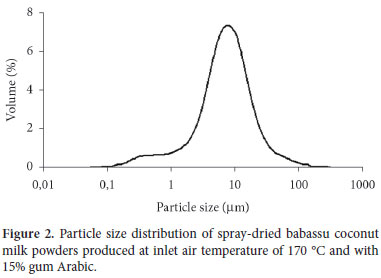The objective of this study was to obtain babassu coconut milk powder microencapsulated by spray drying process using gum Arabic as wall material. Coconut milk was extracted by babassu peeling, grinding (with two parts of water), and vacuum filtration. The milk was pasteurized at 85 ºC for 15 minutes and homogenized to break up the fat globules, rendering the milk a uniform consistency. A central composite rotatable design with a range of independent variables was used: inlet air temperature in the dryer (170-220 ºC) and gum Arabic concentration (10-20%, w/w) on the responses: moisture content (0.52-2.39%), hygroscopicity (6.98-9.86 g adsorbed water/100g solids), water activity (0.14-0.58), lipid oxidation (0.012-0.064 meq peroxide/kg oil), and process yield (20.33-30.19%). All variables influenced significantly the responses evaluated. Microencapsulation was optimized for maximum process yield and minimal lipid oxidation. The coconut milk powder obtained at optimum conditions was characterized in terms of morphology, particle size distribution, bulk and absolute density, porosity, and wettability.
Orbignya phalerata Mart.; spray drying; lipid oxidation; response surface; scanning electron microscopy

 Microencapsulation of babassu coconut milk
Microencapsulation of babassu coconut milk






